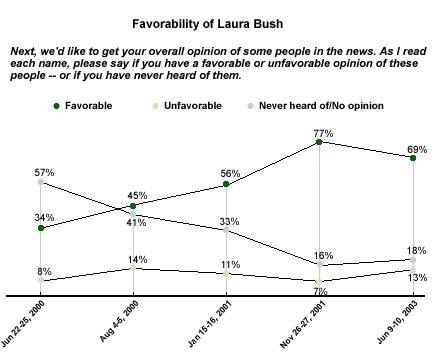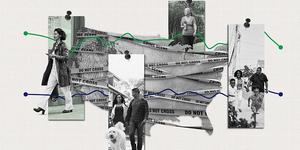The position of first lady has some serious drawbacks. The process of getting the job is brutal and requires a great deal of travel. If you get the job, you're guaranteed intense scrutiny from much of the public and the media. And you're constantly compared to former jobholders, one of whom, in the case for the current first lady, is your mother-in-law.
Recent history has presented three approaches to the job of first lady. The first is to be the strongly supportive spouse who nevertheless avoids partisanship and finds a worthy social issue to call her own, as Laura Bush has done with education, and as Nancy Reagan did with the war on drugs. The second is to take on controversial public policy initiatives, as Hillary Clinton did with healthcare reform -- but this risks vilification by at least two groups: those who disapprove of the initiative, and those who simply disapprove of first ladies helping shape public policy. The third approach is to be Barbara Bush.
The Current First Lady
Laura Bush has never had an unfavorable rating over 14%. A June 9-10 Gallup Poll found that her favorable rating is 69%. In November 2001, just after the Sept. 11 attacks, her approval rating was 77% -- a high number for any public figure.

The Previous Occupants
Barbara Bush was an enormously popular first lady -- she was "everybody's grandmother," as she put it. In August 1992, four months before her husband lost the presidency, a Gallup Poll found she had a 69% favorable rating. Moreover, several years after leaving the White House, she was cited by 40% of Americans as the closest ideal to what a first lady should be -- outranking Hillary Clinton (29%), Nancy Reagan (17%), and Rosalyn Carter (11%).
Hillary Clinton, on the other hand, was nobody's grandma. Although she had many exuberant supporters, her tenure as first lady had more than the normal share of controversy, political missteps, and scandal. In August 1993, 57% of Americans rated her favorably and 33% unfavorably. By January 1996, her favorability rating was down to 43%, her unfavorable rating was up to 51%. In fact, it took one of the worst events of Hillary Clinton's life, as she called it, to garner her Barbara Bush-like public favorability. In February 1998, as the nation took her husband to task over his affair, Hillary Clinton's favorable rating climbed to 60% and stayed at or above that level for more than a year.
Americans have rarely had the same problem coming up with opinions of Hillary Clinton as they have with Laura Bush; in the last 10 years, the number of people expressing no opinion when asked about Clinton has cracked double digits only four times. By contrast, even Gallup's most recent rating of Laura Bush (in June) found 18% holding no opinion of her.
